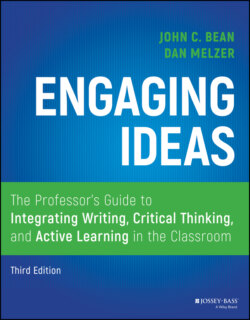Читать книгу Engaging Ideas - John C. Bean - Страница 69
3 Helping Writers Think Rhetorically
ОглавлениеSome years ago John had the opportunity to participate in a statewide assessment of student writing in upper division courses across the curriculum. Researchers collected several hundred papers written by juniors and seniors from a wide range of disciplines at six public universities. The goal for this first‐stage project was descriptive: determining what kinds of papers students were being asked to write and classifying them by whatever categories seemed to emerge. What John and his fellow researchers discovered as they puzzled over many of the papers was that they should have asked for an assignment sheet to be attached to each paper.
John and his fellow researchers' confusion indicated that students were not thinking rhetorically about their purpose or the needs of their audience. Without the assignments, the researchers struggled to understand what many of the papers were doing. Students tended to write directly to the teacher, whose background knowledge the researchers didn't share. The researchers were plopped down in the middle of a conversation to which they hadn't been introduced. As outside readers, they needed papers with effective titles that identified the subject and promised some new or contestable perspective on the subject. They also needed introductions that explained the problem to be addressed, filled in needed background, and offered some kind of thesis statement or purpose statement to indicate the writer's intentions and to forecast the argument.
Clearly students across the disciplines were not being coached to transfer into their upper division writing the rhetorical knowledge introduced in first‐year composition. A goal of most first‐year composition programs is to show students how a writer's decisions are often functions of the writer's rhetorical situation—the writer's purpose, audience, and genre. Particularly, expert writers pose the following kinds of questions about their rhetorical context:
Who are my intended readers?
How much do my readers already know and care about my topic? What is their stance toward my topic?
What is my purpose for writing? What kind of change do I want to bring about in my readers' understanding of my topic? When my readers finish my paper, what do I want them to know, believe, or do?
What genre is most appropriate for my context? What are the features and constraints of this genre? What style, level of language, and document design does this genre require?
How is the genre shaped by the values and expectations of the community of readers and writers who make up the audience (the “discourse community”)?
Our goal in this chapter and the next is to suggest ways that disciplinary instructors can help students practice these rhetorical skills when they write papers in any field. In chapter 3, we introduce the concept of “rhetorical situation,” which includes “purpose,” “audience,” “genre,” and “discourse community.” In chapter 4 we expand on these concepts and provide ideas for designing formal assignments set within authentic rhetorical situations. Scholarship has shown that helping students situate their writing within a rhetorical context helps them transfer knowledge from one writing situation to another (Anson and Moore, 2017; Beaufort, 2007; Carroll, 2002; Carter, 2007). When students learn to wrestle with questions about purpose, audience, genre, and discourse community, they develop a conceptual view of writing that has lifelong usefulness in any communicative context.
